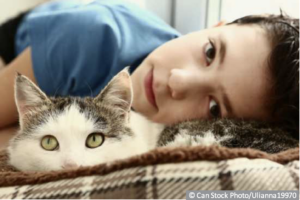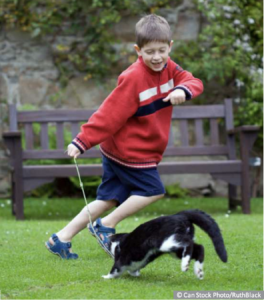Barks Blog
Cats and Kids

by Andrea Carne
The same cannot be said for children and cats. Why? Well, as I illustrated in my opening jest, bad cat interactions rarely result in serious injury—or worse—that make the evening news. A few scratches, the occasional bite and some tears are usually recovered from quickly and life moves on.
But (and this is a big but from me as a cat behavior consultant) this does not mean we shouldn’t take the subject seriously. Far from it, in fact, and my reasoning is this: regardless of the species, interactions between a child and an animal that are unhealthy and unwelcome can cause a great deal of stress to that animal. This, in turn, can lead to any number of health and behavioral issues which may not only shorten the animal’s life, but can also result in them being surrendered to a shelter and/or euthanized for something that could have been avoided in the first place.
I recently visited a client’s home for a consultation involving inappropriate toileting of two young cats adopted from a shelter a few months earlier. What I was confronted with was a very busy household that included three young boys aged under eight, the youngest just a toddler. There was no doubt these young boys LOVED their new feline friends but, unfortunately, they loved them a little too much—from the cats’ perspective at least.
While looking around the home and gathering the background information, I quickly realized the cats had nowhere to escape the obvious noise and chaos of this young family and, most importantly, the parents had no idea how to manage their children’s interactions with the cats, which were frequently forced and overly exuberant. Even a lovely outdoor catio setup had a door and a seat inside so the children could get in with the cats. Suffice to say the cats were stressed, the inappropriate toileting was a cry for help, and I am thankful the client called me sooner rather than later.
If you think this sounds all too familiar, you are right, and it’s nobody’s “fault.” This client was an awesome mom who desperately wanted her children to have a beautiful, healthy, loving relationship with their pet cats, just as she had had as a child. She just didn’t realize that relationships between children and cats sometimes take time and extra special care, and cannot be forced. Every cat is different, and each will have a different tolerance level for human interaction depending on age, background and life experience—which is all a little hard for a young child to understand when they just want a pet they can play with and cuddle.
Animal Magic

We know that, in general, children love animals. Several studies have found that children will choose living creatures over toys. They love spending time with another living, breathing creature they can interact with and that will interact with them in return. However, while this all sounds warm and fuzzy (and it is to a point), it is also this innate need for a child to have reciprocal interaction with an animal that can create problems, especially with cats.
Hart et al. (2018) examined a study by A.H. Kidd and R.M. Kidd (1987) and surmised the following: “The 12- to 30-month-old children [in the study] preferred dogs to cats, presumably because the dogs were interactive and more likely to approach the children, whereas the cats often walked away, thus limiting reciprocal interaction.”
Now in an ideal world of stress-free companion animal ownership, the child would recognize the cat walking away as a sign he doesn’t want to engage and leave it at that. Unfortunately, in my experience, the opposite scenario tends to be more common, wherein the child tries to force the interaction by chasing the cat and attempting to grab him by the tail or fur. Parents will know this rarely has a happy ending, with scratches, tears and an angry, stressed cat left in the aftermath.
But it doesn’t have to be this way. If cat owners were to dedicate the same amount of energy to teaching children how to safely interact with cats as they do with other children and adults (and even dogs), there would most likely be far fewer scratches and much happier cats all around.
Checklist
So, in saying that, here’s my 10-point checklist for encouraging healthy interactions between children and cats:
- Child–cat interactions should always be supervised, particularly when the children are very young.
- Allow the cat choice and teach children the importance of choice at a level they can understand. A cat should always be given the choice of whether to interact or not, whether to play or not and when to leave the interaction of his own accord. Just as children grow tired of a game or activity and want to do something else, cats should also be given that choice and never be forced into continuing. Teach children to sit on the floor and gently hold out a finger towards the cat or gently hold out a toy for the cat to sniff. This is all about asking for the cat’s consent to interact, and it is vitally important to building a healthy relationship. If the cat chooses to come in and sniff the outheld finger or toy, then interaction can commence. If he chooses not to interact, try again later.
- Keep interactive sessions gentle, calm and short—and allow the cat to finish on his own terms and before things get out of control. Lengthy, high-energy play sessions can lead to a cat becoming overly stimulated, which can result in aggressive play. Ensure children use toys to play with the cat and not their own hands. Toys on rods or poles are perfect for keeping little hands out of the way.
- Not all interactions need to involve play. Teach children how to gently stroke a cat and which parts of the body to stroke (head, neck, shoulders, under chin), and bear in mind each individual cat will have his own preferences. Discourage children from picking up the cat unless they are old enough to do so and have been shown how to lift the cat and put him down safely (and with the cat’s consent). Instead, have them sit on the floor to pat the cat and teach them how to use a brush to help with grooming. Encourage children to relax and read a book aloud to the cat as an alternative to play.
- Provide lots of places for the cat to escape to when he needs time out—resting areas high up on tops of cupboards, book cases or a cat tree that are out of reach of the children and where the cat can observe the goings on without being a part of it are essential. When the cat retreats to these areas, the children need to know they are not to disturb him.
- In addition to resting areas, create some kid-free zones for the cat to have some sanctuary. Teach the children that the cat is not to be disturbed if he is eating, sleeping, grooming, hiding, or toileting. If there’s a catio arrangement, let that be a sanctuary where the cat can relax without the children.
- When the children are old enough, teach them about cat body language so they can see for themselves whether the cat is happy or not. If a cat moves in towards the child and rubs his head or body on them, purrs, and holds his tail upright, he is happy. If he is crouched, ears back, tail down and swishing, growling, he should be left alone.
- Older children can also divert some of their energy into teaching the cat tricks like “high five” using positive reinforcement. There are numerous books and online videos that can help with this (see Resources).
- Keep a check on your cat’s health. Cats that are unwell or in pain can have behavioral changes and less tolerance for human interaction—and even less for children.
- Lead by example—children will follow the adult’s lead in interacting with the cat, so make sure your interactions mirror how you’d like your children’s to be. Aversive interactions such as shouting or squirting the cat with a water bottle should be avoided at all costs.
As a cat behavior consultant, I know that stress is a number one cause of a wide range of health and behavioral problems in our feline family members. Stress comes in many forms, and the average cat owner may not even realize it is present until behavioral changes start impacting them (most commonly, inappropriate toileting).
If we can spend more time educating our younger generations how to interact with cats in a way that builds bonds and strengthens relationships—and if we do this from an early age—we will be setting our beloved felines up for much happier, stress-free lives that will be of huge benefit both to them and their loving humans.
References
Hart, L.A., Hart, B.L., Thigpen, A.P., Willits, N.H., Lyons, L.A., & Hundenski, S. (2018). Compatibility of Cats with Children in the Family. Frontiers of Veterinary Science 5:278. Available at: bit.ly/2kqfuSh
Resources
Doggone Safe: doggonesafe.com
Family Paws Parent Education: familypaws.com/resources
IamCasper. (2016). Clicker training videos for cats – beginner & advanced tutorials. Available at: bit.ly/2mr54m3
Karen Pryor Clicker Training/Cat Training: clickertraining.com/cat-training
Kidd, A.H., & Kidd, R.M. (1987). Reactions of Infants and Toddlers to Live and Toy Animals. Psychological Reports (61) 2 455-464. Available at: bit.ly/2mnlOKN
Pryor, K. (2001). Getting Started: Clicker Training for Cats. Waltham, MA: Karen Pryor Clicker Training
Yin, S. (2011). Kids and Dogs: How Kids Should and Should Not Interact with Dogs. Available at: bit.ly/2kSW60o
Andrea Carne is a graduate of the University of Southern Queensland, Australia, where she majored in journalism and drama before, later in life, following her dream to work in the field of animal behavior. She is a qualified veterinary nurse and dog trainer, and member of PPG Australia. Her special area of interest is cat behavior and her passion for it led to the establishment of her own cat behavior consultancy, Cattitude (cattitude.com.au), based in southern Tasmania, through which she offers private in-home consultations.
This article was originally published in the November 2019 issue of BARKS from the Guild.
